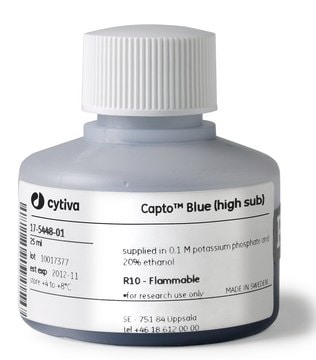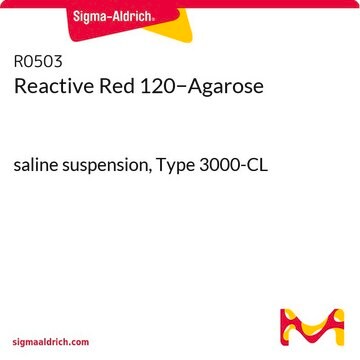Kluczowe dokumenty
C1535
Cibacron Blue 3GA Agarose
Type 3000-CL, saline suspension
Synonim(y):
1-amino-4-[4-[[4-chloro-6-(2-sulfoanilino)-1,3,5-triazin-2-yl]amino]-3-sulfoanilino]-9,10-dioxoanthracene-2-sulfonic acid
Wybierz wielkość
902,00 zł
Wybierz wielkość
About This Item
902,00 zł
Polecane produkty
pochodzenie biologiczne
plant
typ
Type 3000-CL
Formularz
saline suspension
zakres etykietowania
2-6 μmol per per mL
metody
affinity chromatography: suitable
Matryca
cross-linked 4% beaded agarose
pojemność
≥5 mg/mL binding capacity (bovine serum albumin)
przydatność
suitable for chromatography
temp. przechowywania
2-8°C
ciąg SMILES
[Na+].[Na+].[Na+].Nc1c(cc(Nc2ccc(Nc3nc(Cl)nc(Nc4cccc(c4)S([O-])(=O)=O)n3)c(c2)S([O-])(=O)=O)c5C(=O)c6ccccc6C(=O)c15)S([O-])(=O)=O
InChI
1S/C29H20ClN7O11S3.3Na/c30-27-35-28(33-13-4-3-5-15(10-13)49(40,41)42)37-29(36-27)34-18-9-8-14(11-20(18)50(43,44)45)32-19-12-21(51(46,47)48)24(31)23-22(19)25(38)16-6-1-2-7-17(16)26(23)39;;;/h1-12,32H,31H2,(H,40,41,42)(H,43,44,45)(H,46,47,48)(H2,33,34,35,36,37);;;/q;3*+1/p-3
Klucz InChI
VZPXDCIISFTYOM-UHFFFAOYSA-K
Szukasz podobnych produktów? Odwiedź Przewodnik dotyczący porównywania produktów
Zastosowanie
Postać fizyczna
Kod klasy składowania
10 - Combustible liquids
Klasa zagrożenia wodnego (WGK)
WGK 3
Temperatura zapłonu (°F)
Not applicable
Temperatura zapłonu (°C)
Not applicable
Środki ochrony indywidualnej
Eyeshields, Gloves
Wybierz jedną z najnowszych wersji:
Certyfikaty analizy (CoA)
Nie widzisz odpowiedniej wersji?
Jeśli potrzebujesz konkretnej wersji, możesz wyszukać konkretny certyfikat według numeru partii lub serii.
Masz już ten produkt?
Dokumenty związane z niedawno zakupionymi produktami zostały zamieszczone w Bibliotece dokumentów.
Active Filters
Nasz zespół naukowców ma doświadczenie we wszystkich obszarach badań, w tym w naukach przyrodniczych, materiałoznawstwie, syntezie chemicznej, chromatografii, analityce i wielu innych dziedzinach.
Skontaktuj się z zespołem ds. pomocy technicznej






